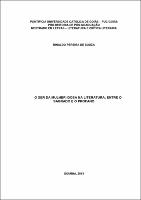| Compartilhamento |


|
Use este identificador para citar ou linkar para este item:
http://tede2.pucgoias.edu.br:8080/handle/tede/3179Registro completo de metadados
| Campo DC | Valor | Idioma |
|---|---|---|
| dc.creator | Souza, Rinaldo Pereira de | - |
| dc.creator.Lattes | http://lattes.cnpq.br/5946375734335611 | por |
| dc.contributor.advisor1 | Rodrigues, Maria Aparecida | - |
| dc.contributor.advisor1Lattes | Maria Aparecida Rodrigues | por |
| dc.contributor.referee1 | Afonso, Lucia Helena Rincon | - |
| dc.contributor.referee1Lattes | http://buscatextual.cnpq.br/buscatextual/visualizacv.do?id=K4708611D8 | por |
| dc.contributor.referee2 | Cruz, Antonio Donizeti da | - |
| dc.contributor.referee2Lattes | http://lattes.cnpq.br/9408709557013563 | por |
| dc.date.accessioned | 2016-08-10T11:06:52Z | - |
| dc.date.available | 2013-09-16 | - |
| dc.date.issued | 2013-02-07 | - |
| dc.identifier.citation | SOUZA, Rinaldo Pereira de. O SER DA MULHER IDOSA NA LITERATURA: ENTRE O SAGRADO E O PROFANO.. 2013. 110 f. Dissertação (Mestrado em Ciências Humanas) - Pontifícia Universidade Católica de Goiás, GOIÂNIA, 2013. | por |
| dc.identifier.uri | http://localhost:8080/tede/handle/tede/3179 | - |
| dc.description.resumo | A presente dissertação tem-se por objetivo analisar a configuração do ser da mulher idosa na literatura, considerando as simbolizações sagradas e profanas a ela atribuída nas estéticas clássica e moderna. Principalmente, a partir da propositura de Walter Benjamin, ao salientar que na obra clássica havia o valor de culto, enquanto que na obra moderna, há o valor de exposição, identifica-se a personagem idosa na literatura. No conto de fadas, a velha é representada como a força negativa, sendo a bruxa ou a feiticeira; nas histórias infanto-juvenis lobatianas, Dona Benta e Tia Nastácia, como contadoras de histórias e educadoras assumem função sagrada, assim divergem das idosas modernas em crise existencial, em busca de autoafirmação, distanciam do ideal clássico, sendo um vir-a-ser. Compõe o corpus deste trabalho textos da literatura clássica, os contos de fadas, Branca de Neve e João e Maria; as histórias infanto-juvenis de Monteiro Lobato, Histórias de Tia Nastácia e Serões de Dona Benta; e os contos modernos de Clarice Lispector, A Partida do Trem, e o conto de Lygia Fagundes Teles, Senhor Diretor. O estudo fundamenta-se nas teorias sobre o poder simbólico, o sagrado e o profano, o Belo e o Feio, arte como representação, narrador e perda da aura. | por |
| dc.description.abstract | The present dissertation aims to analyze the configuration of the elderly woman being in the literature, considering the sacred and profane symbolizations attributed to her in classical and modern aesthetic. Chiefly, from the filing of Benjamin, to emphasize that in classic work there was the value of cult, while that in modern work, there is the value of exposition, identifies the elderly personage in the literature. In fairytales, the old woman is represented the negative force, being the witch or the sorceress; in juvenile stories about wolf, Dona Benta and Tia Nastácia, as storytellers and educators assume sacred function, thus diverge from the elderly modern in existential crisis, in search of self-affirmation, apart from the classical ideal, being a coming-to-be. Compuses the corpus of this study, texts of classic literature, the fairy tales, Branca de Neve and João e Maria; Monteiro Lobato juvenile stories, Histórias de Tia Nastácia and Serões de Dona Benta ; and the modern tales of Clarice Lispector, A Partida do Trem , and Lygia Fagundes Teles tale, Senhor Diretor . The study is based on the theories about the symbolic power, the sacred and the profane, the beautiful and the ugly, art as representation, narrator and loss of aura. | eng |
| dc.description.provenance | Made available in DSpace on 2016-08-10T11:06:52Z (GMT). No. of bitstreams: 1 RINALDO PEREIRA DE SOUZA.pdf: 992368 bytes, checksum: 292a8f690b3c7c53093e442dc378a8bf (MD5) Previous issue date: 2013-02-07 | eng |
| dc.format | application/pdf | por |
| dc.thumbnail.url | http://localhost:8080/tede/retrieve/9423/RINALDO%20PEREIRA%20DE%20SOUZA.pdf.jpg | * |
| dc.language | por | por |
| dc.publisher | Pontifícia Universidade Católica de Goiás | por |
| dc.publisher.department | Ciências Humanas | por |
| dc.publisher.country | BR | por |
| dc.publisher.initials | PUC Goiás | por |
| dc.publisher.program | Literatura e Crítica Literária | por |
| dc.rights | Acesso Aberto | por |
| dc.subject | Personagem feminina | por |
| dc.subject | Estética | por |
| dc.subject | Gênero | por |
| dc.subject | Poder Simbólico | por |
| dc.subject | Crítica Literária | por |
| dc.subject | Female character | eng |
| dc.subject | Aesthetics | eng |
| dc.subject | Gender | eng |
| dc.subject | Symbolic Power | eng |
| dc.subject | Literary Criticism | eng |
| dc.subject.cnpq | CNPQ::LINGUISTICA, LETRAS E ARTES::LETRAS | por |
| dc.title | O SER DA MULHER IDOSA NA LITERATURA: ENTRE O SAGRADO E O PROFANO. | por |
| dc.type | Dissertação | por |
| Aparece nas coleções: | Mestrado em Letras | |
Arquivos associados a este item:
| Arquivo | Descrição | Tamanho | Formato | |
|---|---|---|---|---|
| RINALDO PEREIRA DE SOUZA.pdf | 969,11 kB | Adobe PDF |  Baixar/Abrir Pré-Visualizar |
Os itens no repositório estão protegidos por copyright, com todos os direitos reservados, salvo quando é indicado o contrário.




